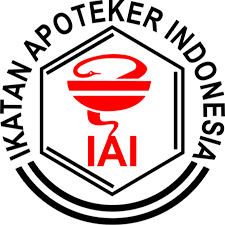Kajian Penggunaan Antibiotik pada Pasien Meningitis dan Ensefalitis Bakteri di Bangsal Rawat Inap Rumah Sakit Rujukan Utama
Diyan Ajeng Rossetyowati(1*), Ika Puspitasari(2), Tri Murti Andayani(3), Titik Nuryastuti(4)(1) Akademi Farmasi Jember
(2) Universitas Gadjah Mada, Yogyakarta
(3) Universitas Gadjah Mada, Yogyakarta
(4) Universitas Gadjah Mada, Yogyakarta
(*) Corresponding Author
Abstract
Inadequate antibiotic therapy for meningitis and bacterial encephalitis is one of the factors that can jeopardize patient safety and turn into a public health issue in a number of nations, including Indonesia. This phenomena has the potential to raise health-care expenses, which should be avoided in the era of the JKN program's implementation. The goal of this research was to describe the profile of antibiotic use and cost in hospitalized meningitis and bacterial encephalitis patients. This cross-sectional observational study took place from January to December 2019. As study materials, patient medical records and billing data were employed. To enhance the data obtained, confirmation with medical and pharmaceutical personnel is required. Antibiotic use and expenditures were described using descriptive analysis. A total of 71 patients, both children and adults, met the study's inclusion criteria. Antibiotics were given to all of the patients, and the results revealed that third generation cephalosporins (49.375%) were the most commonly recommended antibiotic class, either alone or in combination. Antibiotic use receives 46.94% of total medication funding. According to the length of stay category, the majority of patients (45.99 %) were hospitalized for 8-14 days consecutively with antibiotic medication. Antibiotics, which are typically administered to patients with meningitis and bacterial encephalitis, had no effect on the length of stay in the hospital. Antibiotic prescriptions must be carefully reviewed at top referrel hospital, taking into account the local germ map.
Keywords
Full Text:
PDFReferences
Bénard, S., Wright, C., Voisine, J., Olivier, C. W., & Gaudelus, J., 2016. Lifetime cost of meningococcal disease in France: Scenarios of severe meningitis and septicemia with purpura fulminans. Journal of infection and public health, 9(3), 339-347.
Cho, H. K., Lee, H., Kang, J. H., Kim, K. N., Kim, D. S., Kim, Y. K., & Kim, K. H., 2010. The Causative Organisms of Bacterial Meningitis In Korean Children in 1996-2005. Journal of Korean medical science, 25(6), 895-899.
Fiore, A. E., Moroney, J. F., Farley, M. M., Harrison, L. H., Patterson, J. E., Jorgensen, J. H., & Schuchat, A., 2000. Clinical Outcomes Of Meningitis Caused By Streptococcus Pneumoniae in The Era of Antibiotic Resistance. Clinical infectious diseases, 30(1), 71-77.
Griffiths, M. J., McGill, F., & Solomon, T., 2018. Management of acute meningitis. Clinical Medicine, 18(2), 164.
Japardi, I., 2012. Meningitis Meningococcus. USU digital library.
Kemenkes RI., 2019. Panduan Deteksi dan Respon Penyakit Meningitis Meningokokus. Direktorat Jenderal Pencegahan dan Pengendalian Penyakit, Kementerian Kesehatan RI.
Korinek, A. M., Baugnon, T., Golmard, J. L., van Effenterre, R., Coriat, P., & Puybasset, L., 2006. Risk factors for adult nosocomial meningitis after craniotomy roleof antibiotic prophylaxis. Neurosurgery, 59(1), 126-133.
Lee, Y. H., Liu, G., Thiboutot, D. M., Leslie, D. L., & Kirby, J. S., 2014. A retrospective analysis of the duration of oral antibiotic therapy for the treatment of acne among adolescents: investigating practice gaps and potential cost-savings. Journal of the American Academy of Dermatology, 71(1), 70-76.
Mace, S. E., 2008. Acute bacterial meningitis. Emergency medicine clinics of North America, 26(2), 281-317.
Mangistu, A., Gaeseb, J., Uaaka, G., Ndjavera, C., Kambyambya, K., Indongo, L., & Sagwa, E., 2013. Antimicrobial sensitivity patterns of cerebrospinal fluid (CSF) isolates in Namibia: implications for empirical antibiotic treatment of meningitis. Journal of pharmaceutical policy and practice, 6(1), 1-10.
Mitropoulos, I.F., Hermsen, D.E., Rotschafer, D.J., 2008.Central nervous system Infections In: Pharmacotherapy-A pathophysiologic approach. McGraw-Hill. pp:1923-1942
Steiner, I., Budka, H., Chaudhuri, A., Koskiniemi, M., Sainio, K., Salonen, O., & Kennedy, P. G. E., 2005. Viral encephalitis: a review of diagnostic methods and guidelines for management. European journal of Neurology, 12(5), 331-343.
Stockdale, A.J., Weekes, M.P., Aliyu, S.H. An Audit of Acute bacterial meningitis in a large teaching hospital 2005-10., 2011. QJM. 104 (12):1055-1063
Schurz H, Salie M, Tromp G, Hoal EG, Kinnear CJ, Möller M., 2019. The X chromosome and sex-specific effects in infectious disease susceptibility. Human Genomics;13:2:1-12
Tunkel, A.R., Gleaser, C.A., Bloch, K.C., et al., 2008. The management of enchepalitis: clinical practice guidelines by the infectious diseases society of america. IDSA guidelines. 47: p.303-327
Van de Beek, D., De Gans, J., Spanjaard, L., Weisfelt, M., Reitsma, J. B., & Vermeulen, M. 2004. Clinical features and prognostic factors in adults with bacterial meningitis. New England Journal of Medicine, 351(18), 1849-1859.
Viladrich, P.F., 2004. Management of Meningitis Caused by Resistant Streptococcus pneumoniae. Management of Multiple Drug-Resistant Infection. p:31-48
Wang, Q., Wu, Y., Chen, B., & Zhou, J., 2015. Drug concentrations in the serum and cerebrospinal fluid of patients treated with cefoperazone/sulbactam after craniotomy. BMC anesthesiology, 15(1), 1-8.
Wright, C., Wordsworth, R., Glennie, L. Counting the cost of meningoccal disease., 2013 Pediatric Drugs. 15:49-58.
Wachter, K., 2005. Look for Neurologic Complications of Anesthesia. Ob. Gyn. News, 40(18), 10-11.
Article Metrics
Abstract view(s): 2958 time(s)PDF: 6989 time(s)
Refbacks
- There are currently no refbacks.








